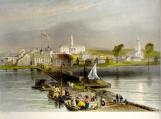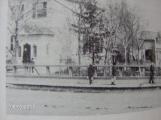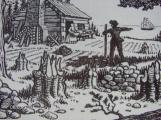1
Paul Kane was born on September 3, 1810, in Mallow, County Cork, Ireland. Paul's father Michael was an English army officer who met Paul's mother Frances Loach, while stationed in Ireland. In 1819 Michael Kane brought his family to Toronto, then the village of York.2
Paul Kane as a young man (presumed self portrait)1825
 Credits:
Credits:Cobourg and District Historical Society and Archives
3
In 1833 William Conger moved to the new town of Cobourg, east of York. Cobourg was the district town for the Newcastle District. Paul Kane followed Conger and his family to Cobourg the same year. Conger was appointed Sheriff, leaving Paul to find employment with the F.S. Clench furniture business.4
Cobourg in 1837 was growning town on the shores of Lake Ontario.1838
 Credits:
Credits:Art Gallery of Northumberland permanent collection
The Charlotte Horner Collection
6
While Paul Kane worked for the Clench furniture business, he lived with the Clench family.9
In 1802 by an act of the first Legislative Assembly of Upper Canada, four administative districts were established in addition to the District of York. Each district was allowed representation in the Legislature and had a jail and court house. The newly established district of Newcastle was to have its district town established at Presqu'isle Point. In 1804 a murder committed at Scugog Lake was to provide the first trial in the district. Judge, jury, crown attorney and the accused were all in York and were transported to Presqu'isle in the schooner "Speedy". A storm came up and the ship was lost trying to land in the new town. The government decided that Presqu'isle was not the best choice. The village of Amherst, further west of Presqu'isle was selected. Within a year a court house and jail were built. As the settlement grew it was renamed Cobourg in honour of the marriage of Princess Charlottle to Prince Leopold of Saxe-Coburg Germany (Queen Victoria's uncle).10
Stone Stable of James Calcutt1812
Cobourg, Ontario
 Credits:
Credits:Cobourg and District Historical Society and Archives


